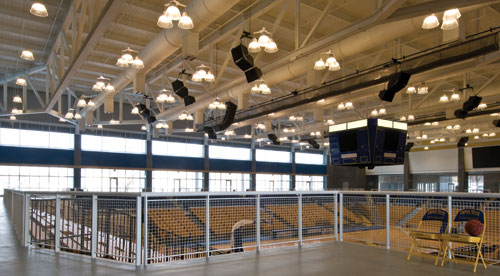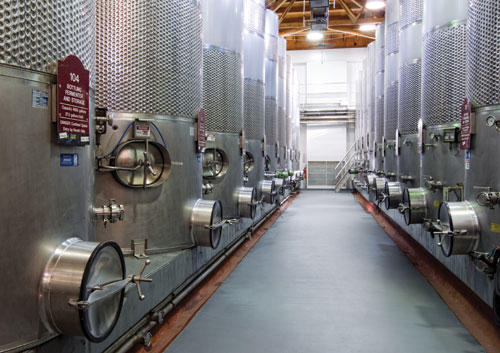Advancements and Applications in Resinous Floors and Walls
Safe, cleanable, and durable, resinous flooring can be specified in numerous applications
![]() Continuing Education
Continuing Education
Use the following learning objectives to focus your study while reading this month’s Continuing Education article.
Learning Objectives - After reading this article, you will be able to:
- Discuss resinous flooring products and their applications.
- Summarize the advantages of resinous flooring.
- Identify the sustainability features of resinous flooring and how they contribute to LEED® points.
- Describe the steps required to ensure a successful flooring installation.
Faced with the task of specifying a flooring product, design professionals are guided by the specific needs of the project. Cost-effectiveness, durability, safety standards, overall performance, and design goals are all features that need to be evaluated when selecting a flooring system for any of today's many commercial and industrial applications. One material that meets multiple requirements is resinous flooring. Formulated from different resins, it has many advantages over other flooring systems.
Traditional flooring systems
Before discussing those advantages, it is useful to review the characteristics and drawbacks of commonly used traditional commercial flooring systems, such as vinyl composite tile (VCT), vinyl sheeting, terrazzo, carpeting, and sealed concrete.
Vinyl Composite Tiles and Vinyl Sheeting
Vinyl flooring is composed of colored vinyl chips formed into solid sheets of varying thicknesses for vinyl sheeting and cut into 12-inch squares for vinyl tiles. It has a low cost, durability, and ease of maintenance. Vinyl flooring is water resistant and can be repeatedly refinished with chemical strippers and mechanical buffing equipment. Its drawbacks include:
- Inability to stand up well to heavy loads and can be damaged by sharp objects.
- Vinyl tiles are easy to replace, vinyl sheeting is not.
- Vinyl tile joins and sheet flooring seams may present cleaning problems and can harbor bacteria.
- While vinyl is generally resistant to stains, it is susceptible to discoloration when it comes in contact with rubber such as rubber-backing matting.
Terrazzo
Terrazzo is a composite material poured in place or precast. It consists of marble, quartz, granite, and glass and is typically poured with a cementitious binder. It is then cured, ground, and polished to a smooth surface. Waterproof, durable, easily cleanable, and environmentally sustainable, its major disadvantages are its expense and slipperiness when wet.
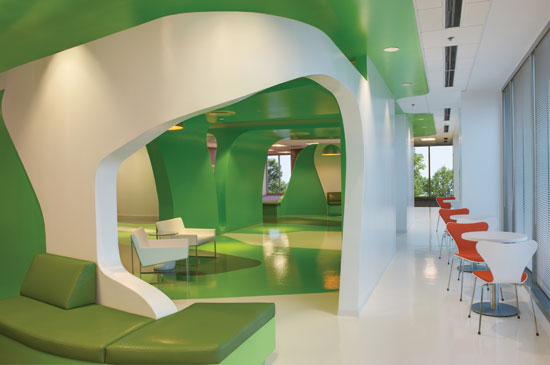 |
Decorative troweled epoxy floor unifies the design of a corporate office. Photo courtesy of Stonhard |
Carpeting
While aesthetically preferable in some settings, carpeting is a potential health risk for many commercial and industrial applications. It can harbor bacteria, is expensive to maintain, and needs frequent cleaning. A dry concrete subfloor is essential, otherwise mold can develop beneath the underside of the carpeting.
| Resinous flooring materials |
The three materials commonly used for resinous flooring are epoxy, polyurethane, and acrylic (MMA). EpoxyA copolymer derived from two or more monomeric species, epoxy is formed from two different chemicals, referred to as the “resin” or “compound” and the “hardener” or “activator.” Epoxy has a wide range of applications the include flooring, fiber-reinforced plastic materials and general purpose adhesives. PolyurethanePolyurethane polymers are formed by combining two bi- or higher functional monomers (a molecule that may bind chemically to other molecules to form a polymer). Polyurethanes are used in the manufacture of a wide range of products, from foam seating, rigid foam insulation panels to microcellular foam seals and gaskets and high-performance adhesives. Acrylic (MMA)Acrylic resin is a general term for any one of the plastics (resin) generated through chemical reaction by applying polymerization initiator and heat to a monomer. Methyl methacrylate monomer (MMA) is a transparent, colorless fluid substance and emits highly offensive odor during application. Surrounding areas must be properly ventilated and evacuated during installation. |
Sealed Concrete
Eco-friendly, a sealed concrete floor is one of the most cost-efficient floor coverings and offers a multitude of design options. Drawbacksinclude the need for resealing every few months in high-traffic areas; it transmits sound easily; and can be expensive if several colors and designs are specified.
Resinous flooring
Typically comprised of materials that include polymeric materials such as epoxy, polyurethane, and acrylic (MMA) (see sidebar), resinous flooring is cast in place. In addition to its many advantages over traditional systems, poured-in-place resinous flooring has the significant benefit of meeting multiple requirements for a wide range of applications (see sidebar about defining performance on the next page). Through a strategic mix of materials typically categorized by manufacturers as different products, resinous flooring will serve heavy-duty manufacturing plants to signature corporate lobbies. Advantages of resinous flooring include:
Cleanability
With no joins or seams, a poured-in-place system cannot harbor bacteria or present cleaning difficulties. No buffing or waxing required.
Safety
Aware that cleanability can be associated with a high slippage index (a smoother floor can be more slippery), manufacturers offer resinous flooring systems in different textures. Data sheets will include both a Coefficient of Friction for a dry floor and Slip Index for a wet floor.
 |
A seamless troweled epoxy floor is easy to maintain in classrooms. Photo courtesy of Stonhard |
 |
Resistance to Chemicals
A major advantage of resinous flooring is its resistance to corrosive chemicals. A manufacturer will typically test for the damaging effects of corrosive chemicals by totally immersing samples of cured flooring in different chemicals for seven days at normal room temperatures. The rated results are categorized by acids, alkalis and salts, and solvents and other chemicals and are available on a manufacturer's data sheet. Manufacturers also test for VOC (volatile organic compound), one of a number of chemicals, including benzene and acetone, that evaporate or vaporize readily and are harmful to human health and the environment.
Durability
Resinous flooring systems have a wide range of durability depending upon materials and configurations. Physical characteristics, such as strength and hardness data, are available for each product from the manufacturer.
They are also crack resistant. Unlike ceramic or quarry tile, resinous systems will not crack or present tripping or cleaning hazards.
Design and Color Palette Versatility
Resinous flooring is available in a range of colors and appearances and can be poured according to custom design specifications.
Low-Cost Life Cycle
While its initial costs are higher than vinyl systems, decorative resinous flooring has lower long-term costs compared with terrazzo, high-grade carpeting, VCT, rubberized terrazzo, and non-formulated vinyl.
 |
| Defining Performance |
Typically a manufacturer will conduct its own performance tests according to American Society for Testing and Materials (ASTM) standards. VOC content (ASTM D-2369, Method E) tests for VOC (volatile organic compound) content. Results are in grams per liter (g/L). An epoxy stain-resistant flake system, for example, could have a VOC content of 34 g/L. Test results for other chemicals are available from the manufacturer. Slip resistance index (ASTM F-1679, F-2508) is directly related to the smoothness of the floor (the smoother the floor the less slip resistance). Measured in ranges from 0 to > 1. The greater the number the more slip resistant. Troweled epoxy mortar system could have a Slip Index of 0.66 when wet. Abrasion resistance (ASTM D-4060 CS-17) is the ability to withstand rolling loads. Abrasion resistance is measured by running a gritty surface across a coating for a selected number of times and determining how much of the coating has been removed. The sample is weighed prior to and after the test. Units are in gram max weight loss. Typical example: 0.03 g for decorative epoxy mortar. Tensile strength (ASTM D-2794) is the resistance of the material from being pulled apart from two opposite forces. Tensile strength is measured in terms of psi (pounds per square inch). Typical example: 1200 psi for a resilient urethane flooring system Compression (ASTM C-579) is the resistance of a material from being compressed to the point of cracking or other failure standard. Compressive strength is measured in psi (pounds per square inch). Typical example: 10,000 psi for a heavyduty troweled epoxy system. |
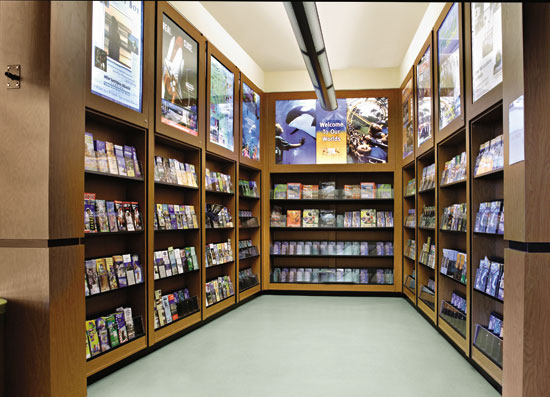 |
A layer of aggregate adds color and texture to a moderate- to high-traffic area. Photo courtesy of Stonhard |
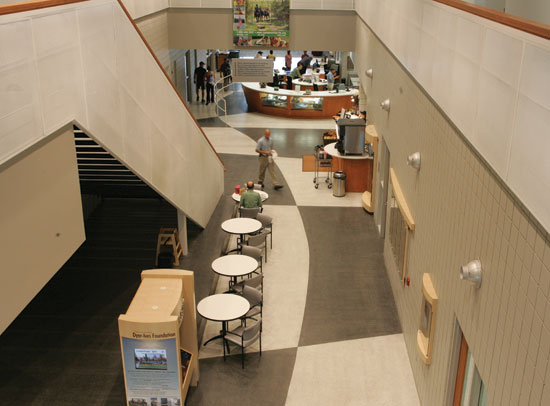 |
Troweled resilient urethane flooring in a YMCA Photo courtesy of Stonhard |
Applications of resinous flooring
With multiple product choices manufactured for different needs, resinous flooring has a wide range of applications:
Construction markets
Healthcare
Pharmaceutical/Biotech
Food & Beverage
Chemical Processing
Education
General Manufacturing
Electronics
Hospitality
Public Spaces
Interior environments
Traffic Aisles
Airport Concourses
Processing Areas
Cafeterias
Control Rooms
Operating Rooms
Packaging Lines
Classrooms
Assembly Areas
Corridors
Machine Areas
Lobbies
Resinous flooring option
When specifying resinous flooring systems, design professionals should be aware that resinous material—epoxy, urethane, and acrylic (MMA)—have different characteristics regarding curing time, heat limitation, chemical resistance, and so forth (see table of resin options in the online version of this article). For instance, acrylic (MMA) has the fastest curing time, while urethane flooring is partially renewable and excellent for chemical resistance.
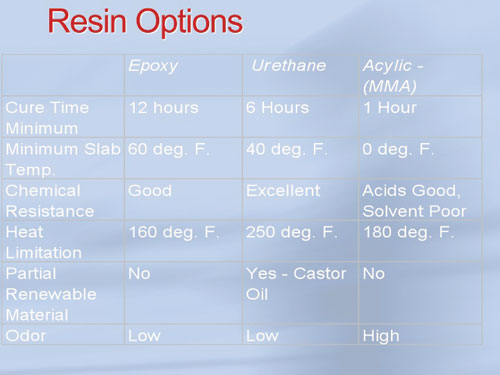 |
Flooring System Configurations
Liners, coatings, troweled mortar, broadcast systems, and terrazzo alternatives are all types of resinous flooring. Configurations vary according to specific needs such as performance requirements, withstanding high temperatures, static and non-sparking properties, withstanding high traffic and noise reduction. Fillers and components are utilized in different products to enhance performance and sustainability.
Coatings. A resinous coating is used to protect and prolong the life of the floor. Available in a wide range of finishes, pigmented or clear, epoxy and urethane formulations, coatings can be applied in conjunction with a resinous floor system, or as a coating over a concrete subfloor. Thicknesses range from 8 mls to 30 mls. A manufacturer may categorize coatings as “complementary” products.
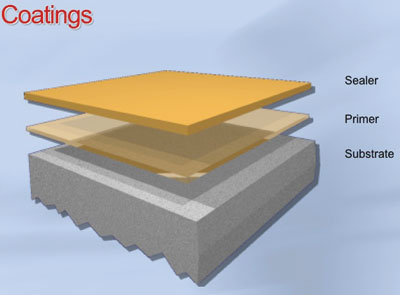 |
Troweled mortar. A troweled epoxy mortar is a typical choice for flooring with chemical, abrasion, and impact requirements. Hand-troweled like concrete, mortar is applied at thicknesses ranging from 3/16 inch to 3/8 inch. It is suitable for heavy-duty environments such as commercial kitchens or industrial facilities. Some systems include recycled glass fillers and rapidly renewable soy-based resins to increase texture and to withstand thermal cycling/thermal shock for use in food environments.
Troweled epoxy mortar is also utilized for renovating and replacing damaged floors.
 |
Problems with quarry tile in a bacteriaprone commercial kitchen included cracking, cleaning difficulties, and danger from slipping and tripping. The solution was a poured, hand troweled epoxy mortar floor. Photo courtesy of Stonhard |
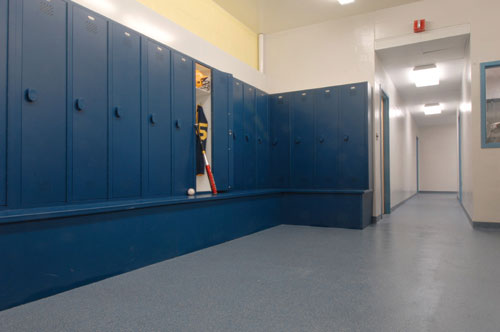 |
Long-lasting, easy-to-clean flooring for a locker room included a troweled epoxy base and an aggregate layer broadcast above an undercoat. Photo courtesy of Stonhard |
 |
Cost-effective textured floor for a light traffic restroom has two layers of broadcast aggregate. Photo courtesy of Stonhard |
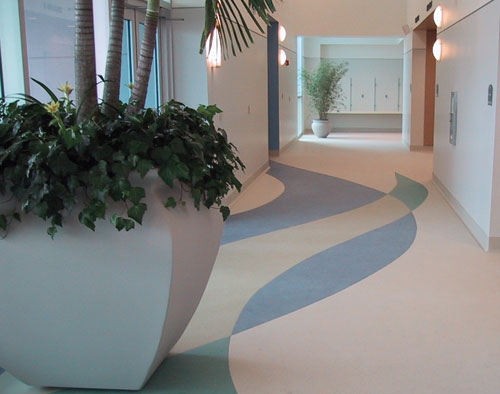 |
Flooring configuration with vinyl flake broadcast delivers a wear-resistant finish to a corporate corridor. Photo courtesy of Stonhard |
 |
Configuration of decorative troweled mortar flooring. |
Broadcast systems. Many configurations for moderate to high-performance needs require one or two layers of aggregate between the primer, undercoat, and sealer. In addition to durability, aggregates add texture, color, and static control. Silica sand, colored quartz sand, recycled glass fillers, or other aggregates are broadcast over a wet epoxy primer or undercoat by methods that date back to when farmers cast seeds on newly prepared soil. Today, installers ideally use machines to achieve a regular even spread. The entire floor is coated and broadcast to refusal (meaning that it has enough aggregates in the material to make it appear dry; otherwise wet spots will appear and affect the look and consistency of the texture). Reclaimed broadcast materials should not be reused.
The thickness of broadcast layers ranges from 1/16 inch to 3/16 inch. As in all flooring systems, the condition of the concrete substrate is critical to the performance of the floor. With its extensive range of finishes and color options, a vinyl flake broadcast system is often specified for decorative finishes. Flakes come in both small and large sizes.
Terrazzo alternatives. A cost-effective alternative to terrazzo is a decorative troweled epoxy mortar system. Recommended for pharmaceutical, research, education, and healthcare applications and used extensively in commercial environments, it is smooth, stain and wear resistant and has low maintenance. Also typically available in decorative custom patterns in an extensive palette, it is, unlike terrazzo, slip resistant. Some decorative epoxy systems utilize recycled glass chips. Typical thicknesses range from 3/16 inch to 1/4 inch.
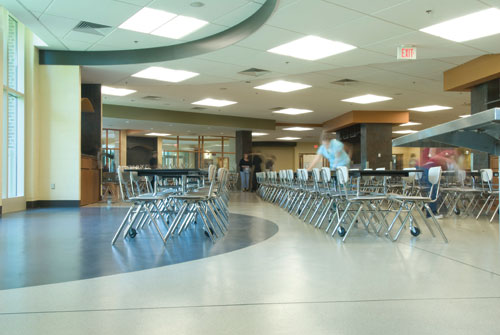 |
This decorative troweled epoxy system in a cafeteria is slip resistant. Photo courtesy of Stonhard |
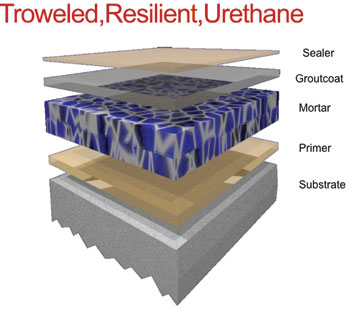 |
Troweled urethane configuration can be highly decorative. |
Troweled resilient urethane. One resinous flooring option with a faster drying time than epoxy is a troweled urethane system, suited for high-profile entertainment, retail, healthcare, and public spaces. With free form and distinctive design capabilities, it competes with vinyl sheeting and carpet. The system is sound absorbent, ergonomic, and stain resistant with a solid, matte finish. Thicknesses range from 1/8 inch to 3/16 inch.
Alternative to stained concrete. A quartz aggregate broadcast system that incorporates decorative stains delivers the look of stained concrete without the drawbacks mentioned above. The 3/32-inch-thick system is durable, UV resistant, slip resistant, textured, and has low maintenance. It is also less labor intensive to install than concrete, and has a comparatively fast turn-around time. Markets include public spaces, education, retail, entertainment, and restaurants.
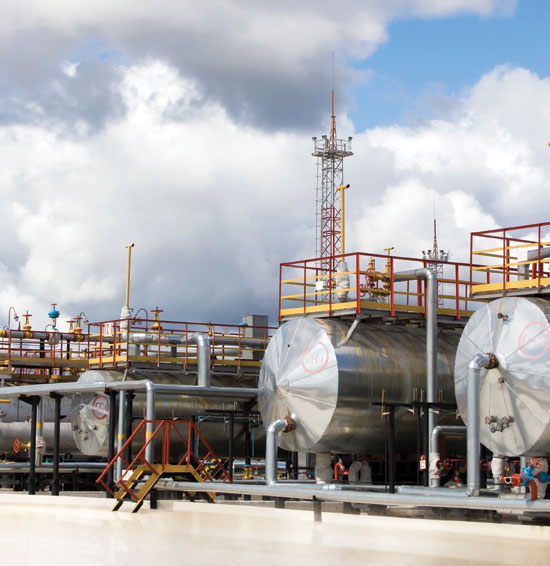 |
High-performing mixes perform in corrosive environments. Photo courtesy of Stonhard |
Resin Linings
Not as decorative as other resinous systems, high performing mixes that include epoxy, urethane, polyester, and vinyl ester perform under extreme physical conditions and provide lining protection for ultra-corrosive environments. Markets include pulp and paper, water/wastewater, chemical, food and beverage, and general manufacturing and parking garages.
Urethane Elastomeric Membrane
Durable, long lasting, epoxy and urethane-based waterproof membranes protect the surfaces of high pedestrian and vehicular traffic areas such as parking structures, ramps, stadium concourses, helipads, and pedestrian bridges. They are low maintenance and can stand up to harsh elements such as sun, salts, and corrosive fluids. Traffic bearing membranes are typically 60 mls to 80 mls thick.
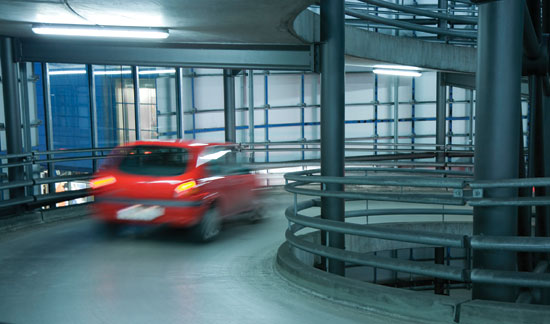 |
A urethane elastomeric membrane protects a stadium ramp. Photo courtesy of Stonhard |
Slip resistant, abrasion, fire and crack resistant, these membranes are also used to protect areas below mechanical rooms, pump and mezzanine floors from water damage. Reinforced with fiberglass an ultra-tough version can be specified for any indoor space that cannot tolerate moisture. Waterproofing membranes are typically 30 mls to 40 mls thick.
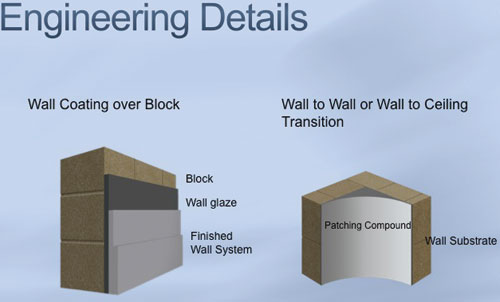 |
Engineering details of wall coating over block and wall transitions. Image by Stonhard |
 |
Details of resinous wall systems with and without wallboard. Image by Stonhard |
Resinous wall systems
 |
Resinous wall system in a beverage facility. Photo courtesy of Stonhard |
Resinous glazes may be applied to walls. Specifically designed for vertical surfaces, wall system products provide a seamless, smooth, impact-resistant, and stain- and splash-resistant surface that works in conjunction with resinous flooring systems. Different formulations and additions such as engineering fabric, enhance the system's mechanical strength and resistance to rigorous conditions. Micro-fiberglass additives will, for example, offer extra protection against cracking and chipping. Typical thicknesses range from 10 mls to 25 mls.
Resinous epoxy wall systems with multiple color choices are available in vinyl flake broadcasting and mortar systems.
Markets include healthcare, education, general manufacturing, pharmaceutical, vivariums, food processing, research, and correctional institutions.
Sustainability
When achieving LEED® certification, design professionals should consult with the resinous flooring manufacturer, who can suggest innovative products that will contribute points.
Following are the categories in LEED 2009 New Construction and Major Renovations (LEED 2012, renamed LEED v4, will not be voted on until June 2013) where resinous flooring may add LEED points to a project:
Material and Resources
MR Credit 1.1 Building Reuse: Reuse—Maintain Existing Walls, Floors and Roof, 1–3 Points
Intent
To extend the life cycle of existing building stock, conserve resources, retain cultural resources, reduce waste and reduce environmental impacts of new buildings as they relate to materials manufacturing and transport. Potential Technologies & Strategies Consider reusing existing, previously-occupied building structures, envelopes and elements. Remove elements that pose a contamination risk to building occupants...
Resinous flooring systems can be used to rehabilitate an existing building and lessen the need for new facilities.
MR Credit 2: Construction Waste Management, 1–2 Points
Intent
To divert construction and demolition debris from disposal in landfills and incineration facilities. Redirect recyclable recovered resources back to the manufacturing process and reusable materials to appropriate sites.
One leading resinous flooring manufacturer reduces waste up to 85 percent through unique packaging by minimizing metal can waste and recyclable packaging.
MR Credit 4: Recycled Content, 1–2 Points
Intent
To increase demand for building products that incorporate recycled content materials, thereby reducing impacts resulting from extraction and processing of virgin materials.
Some resinous flooring products are formulated using recycled glass aggregate.
MR Credit 6: Rapidly Renewable Materials, 1 Point
Intent
To reduce the use and depletion of finite raw materials and long-cycle renewable materials by replacing them with rapidly renewable materials.
Some resinous flooring products are formulated and designed with rapidly renewable bio-based materials.
IEQ Credit 4.2: Low-Emitting Materials—Paints and Coatings, 1 Point
Intent
To reduce the quantity of indoor air contaminants that are odorous, irritating and/or harmful to the comfort and well-being of installers and occupants.
Most of resinous flooring products meet and exceed VOC requirements for floor coatings.
Ensuring successful installations
Installation of successful resinous flooring is time consuming. Design professionals should note that competent and knowledgeable installation of resinous flooring is critical to both meeting design goals and ensuring long term durability of the flooring. Since problems are not usually visible in a newly installed floor, any remediation has to be inconveniently addressed after the building is occupied. Specifying a turnkey flooring system where the manufacture installs its own product makes a lot of business sense.
Mechanical Preparation of the Subfloor
The condition of the concrete substrate is critical to the performance of the floor. There are several mechanical methods for preparing the concrete subfloor before installing the flooring system.
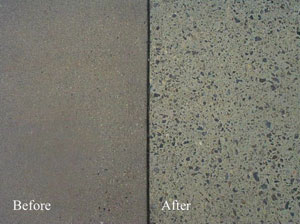 |
Caption (class="mediumText") Photo courtesy of Stonhard |
Abrasive shot blast. A stream of abrasive material is forcibly propelled under high pressure to smooth a rough surface or remove surface contaminants. It is the standard approach for preparing new concrete so the flooring bonds well.
Diamond grinders. Diamond grinders are the most efficient tools for eliminating trowel marks, smoothing surfaces and rough edges, removing coatings and grinding high spots from concrete surfaces. They should be used in conjunction with HEPA-filtered dust extraction. They are generally used if only a coating is to be applied so the profile of the concrete below will not show.
Scarification. The most severe method is scarifying. Steel and or carbide star shaped cutters mounted in rows around the perimeter of a rotating drum remove high spots and contaminants such as oils and grease. Scarifying can, however, leave a more pronounced profile than abrasive shot blasting that may require smoothing.
Moisture Emission from the Concrete Slab
If flooring materials are installed on a slab before it has reached an acceptable level of dryness, moisture can prevent proper curing or lead to a breakdown due to the development of a saturated high pH environment at the surface of a slab. The affects of high moisture levels in a concrete sub-floor can not only lead to failure of the flooring system but can also lead to costly construction delays, indoor air quality issues and the legal disputes that follow when these problems develop.
Osmotic pressure. Because of increasing osmotic pressure from water passing through a semi-permeable membrane—the concrete in this case—the force of gaseous moisture will build up at the surface of the concrete and can cause blistering of the flooring system.
The most common test required by manufacturers has been the measurement of the Moisture Vapor Emission Rate (MVER) by the calcium chloride method described in ASTM F 1869. A capsule of calcium chloride designed to measure moisture weight gain is placed on the concrete for several hours. The maximum permissible weight gain that ensures the flooring will not be compromised by moisture, depends upon the flooring system to be used. If coatings are to be used, weight gain could be between 1 and 2 lb per 1,000 square feet per 24 hours; for broadcast systems, no more than 3 lb, and for mortar systems 3 to 7 lb. If the osmotic pressure exceeds permissible amounts, an osmotic resistant grout is applied which can reduce osmotic pressure from 15 lb to less than 3 lb. One patch of osmotic-resistant grout 1/8 inch thick will reduce osmotic pressure over 1,000 square feet of flooring.
The MVER test measures moisture pressure from the top 1/2 inch to 3/4 inch of the concrete. Some flooring manufacturers are now requiring that the concrete's internal relative humidity level be tested in accordance with ASTM F 2170. The reason being that measuring the concrete's internal relative humidity helps to determine what the moisture level in the slab will be once the flooring materials are installed.
Termination details. Manufacturers recommend that attention be paid to termination details of where the flooring meets doorways, walls, and columns in order to maintain the integrity of the flooring system.
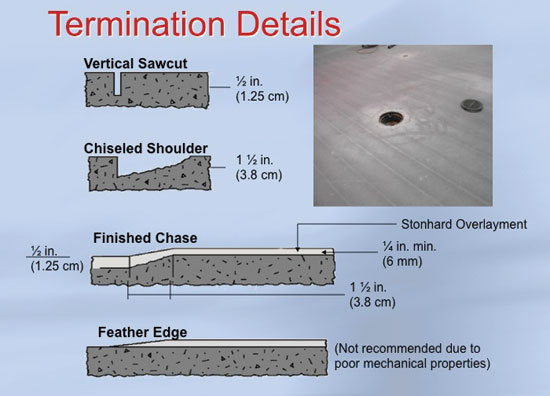 |
Methods for treating joints. Photo courtesy of Stonhard |
Joint treatments. All cracks should be treated before flooring is installed. Treatment should follow accepted methods according to whether the joint has potential movement or not.
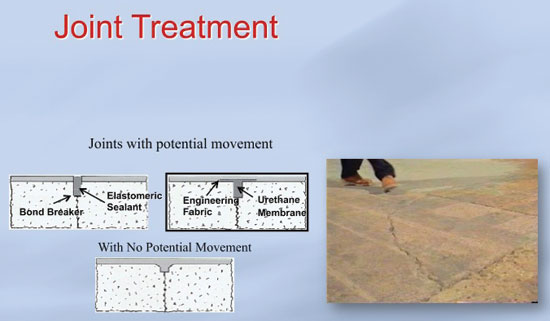 |
Methods for treating joints. Photo courtesy of Stonhard |
Isolation and expansion joints. Expansion and control joints are required in floors. Expansion joints must extend through both the flooring and the substrate and are designed to accommodate continuing movement in the structure throughout the life of the building caused by expansion and/or contraction due to thermal or other effects.
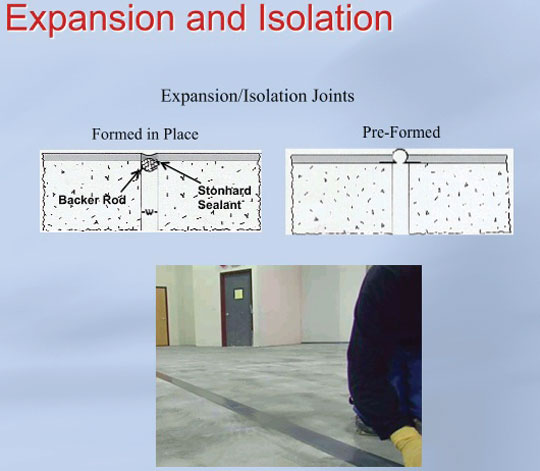 |
Expansion and isolation joints are required on all floors. Photo courtesy of Stonhard |
Case Studies
| Education Application Coppin State University, Baltimore, Maryland |
||
Coppin State University, a 52-acre campus in Baltimore, Maryland, unveiled its new $136-million, 246,000-square-foot Physical Education Complex in 2010. When plans were drawn up for the design of the basketball arena, polished concrete floors were specified for corridors, lobbies, and locker rooms. However, as work began, project managers were extremely unhappy with the unsatisfactory appearance of the first applications in the locker rooms and put a halt to the entire installation. Finding themselves in an unexpected situation, and drawing from numerous previous positive experiences with a resinous flooring systems manufacturer, the project superintendent reached out to it for guidance. The manufacturer guaranteed a long-lasting decorative floor system that could be installed quickly and at a fraction of the cost of the originally specified polished concrete. The manufacturer recommended a liquidapplied, urethane membrane for use on horizontal applications as a crack bridging isolation layer for the surface of the concrete substrate. The urethane membrane filled all cracks in the floor surface creating a smooth surface. The next step in the installation process a nominal 1/16-inchthick resurfacing system with a decorative stainresistant, durable, low-maintenance surface. A colored epoxy undercoat and a layer of colorful, broadcasted vinyl flakes, finished off with a clear urethane sealer, resulted in decorative, eyecatching floors in the complex’s new lobbies, concourses, walkways, restrooms, locker rooms, and pool observation deck. Facility planners and project managers were very satisfied by the quick and cost-effective remediation of the situation. |
| Transforming Production Facilities The Biltmore Winery, Asheville, North Carolina |
||
The Biltmore Winery at the Biltmore Estate in Asheville, North Carolina, is the most visited winery in the country. Each year, the winery harvests and processes 250 tons of grapes in its extensive production facilities, operating under a vigorous schedule that takes a heavy toll on the floors. Many floors in Biltmore’s production facilities were original to the building, and after 25 years of wear and tear, needed refurbishment. Additionally, the painted walls in the winery continually peeled in the harsh environment and had been repainted several times in an attempt to remedy the situation. The condition of Biltmore’s floors and walls not only troubled Biltmore management, but also presented aesthetic concerns, since many parts of the facility are open to public tours, welcoming thousands of wine enthusiasts each year. Biltmore management knew the positive benefits that new floors and walls would bring to the facilities and selected several resinous systems that could address all their needs. These systems helped transform both production facilities and improve work conditions. In 2008, the flooring manufacturer began by conducting a careful analysis of Biltmore’s needs and designed a multi-phase plan that included floor, wall and lining systems that would perform well in the production environment. When Biltmore planners were skeptical whether a wall coating could stand up to the conditions in their facilities, the manufacturer installed onsite samples to demonstrate the durability of the product. Convinced, Biltmore installed more than 8,800 square feet of flooring and 7,500 square feet of wall coatings between 2008 and 2010. A troweled polyurethane textured mortar system was installed in the tank room and grape processing areas. The highly resistant polyurethane mortar floor system provided a durable floor surface that could withstand heavy wear, impact, abrasion, thermal shock, and thermal cycling. These areas also received an application of epoxy wall glaze, which remedied all of the former wall problems by providing a smooth, easy-to-clean, chemicalresistant wall surface. The manufacturer installed troweled epoxy mortar flooring in Biltmore’s champagne bottling area and car exhibit space. The chemical and abrasion-resistant floors were sealed with a protective epoxy coating, which delivered a durable clean-line aesthetic with increased cleanability. The same troweled epoxy mortar was installed in a batching room and elevator lobby. In addition, the manufacturer completed outdoor work at the Biltmore facility. A weatherproof and protective polyureapolyurethane hybrid lining was applied to the outdoor welcome cabana and a rapid-installation polyurethane mortar system was used to complete an outdoor fountain basin. Odor control during installation was imperative for Biltmore, as were the needs for crews to work around stationary equipment and to complete some of the work at night, to accommodate Biltmore’s production and public tour schedules. “The floors look beautiful and I’m confident that they, along with the walls, will be there for many, many years,” says Bill Lynch, production manager. |
| Healthcare Application Huntsville Hospital, Alabama |
||
Huntsville Hospital in Huntsville, Alabama, the largest locally owned, not-for-profit hospital in the nation, with 881 acute care beds, envisioned its new 45,000-square-foot ER and Trauma Center by Chapman Sisson Architects to be cutting-edge in design and critically functional. The hospital had experienced problems with its vinyl tile flooring throughout other areas of its facility, especially in the ERs. Repairing cracked, stained and damaged vinyl involved shutting down much-needed, round-the-clock areas. In addition to the necessary floor repairs was the challenge of Betadine staining on Operating Room floors. Betadine, a necessary antiseptic chemical that leaves yellowish-brown stains on traditional vinyl tile and sheet goods, is a chronic problem in healthcare facilities. The design group specified a stylized, long-lasting, easy to maintain floor that would hold up to Betadine staining, remain ergonomic for staff members who spend hours standing and muffle the sounds from voices, wheeled carts, and throngs of visitors each day. A seamless urethane floor system infused with rubber aggregate was selected for its ergonomic and sound-reducing qualities along with stain resistance. An integral coving material was troweled along floor bases and up onto walls for a sanitary, low-maintenance system. There were no seams or joints and no waxing was required. The floors could also stand up to the heavy loads found in hospitals. Furthermore, if the floors were cleaned within eight hours of Betadine spills with a fast-acting, easy-to-use stain remover provided by the flooring manufacturer, no staining would occur. Warm earth tones were chosen to create a contemporary, non-sterile look. Swirling patterns combined with tweed colors created pathways to aid patients, staff, and visitors with wayfinding. Originally, the space that the new ER and Trauma Center now occupies was intended to be a parking deck and the concrete slab had already been poured. When design plans changed from parking deck to the new facility the architects were concerned about how this would affect the permanent flooring. The flooring manufacturer’s installation crews leveled the concrete. They then applied a patching mortar before installing the flooring system to allow for the best possible bond between substrate and floor. Since the new installation, an additional 25,000 square feet of resinous flooring have been installed in the “old” ER and Trauma Center at Huntsville. |
Conclusion
Resinous flooring has many advantages over traditional systems, such as vinyl tiles and sheeting, terrazzo, sealed concrete, and carpeting. It is durable, cleanable, safe, cost effective, and resistant to chemicals. With its versatile color palette, it also offers many custom design possibilities. Available in a number of configurations for applications ranging from healthcare, food and beverage, to sports facilities and corporate offices, it serves a multitude of markets. Design professionals should note that competent and professional installation is critical for a long-lasting successful floor and should evaluate the option of specifying a turnkey flooring system that includes installation.
 |
Stonhard is the unprecedented leader in manufacturing and installing high-performance epoxy and urethane floor, wall and lining systems. Stonhard’s seamless, long-wearing, and easy-to-clean systems are engineered to perform in both industrial and commercial environments without sacrificing design and innovative vision. www.stonhard.com |

